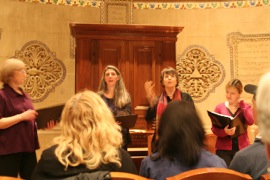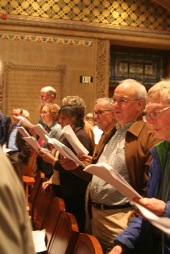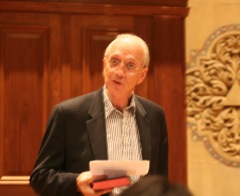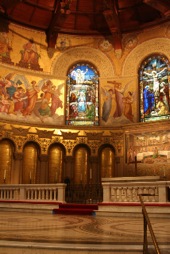
I enter Stanford’s Memorial church and the wonder begins. The ornate church, a stylistic mixture of Romanesque and Mission Revival, is stunning, and the organ sounds of a Bach prelude and fugue add to the ambience. We take seats in the side chapel, and I gaze around at the 50 or so attendees settling in — who are these folks? My neighbor apologizes to me in advance, saying he is not in good voice that evening. I don’t bother warning him about me, he’ll find out soon enough. I discover he is Richard Jones, who was paid to sing chant in college in Los Angeles many years ago. Since then he, and others in the room, have attended some of the many chant retreats given by guest speaker, Stanford Professor Bill Mahrt. Bill is also the director of Stanford’s Early Music Singers and of the Saint Ann Choir.
When Susan Hellauer and the other not-so-Anonymous 4 take the front and begin by demonstrating the eight basic Medieval modes (ancient scales) in unison, I am reassured. Susan’s voice is rich and resonant, her manner learned, humorous and encouraging. After each line she and the group sing, we hear a full 2-second reverb behind us. The result is completely ethereal. We have been transported back in time to the 13th century and the monastic spirit summoned.

Now it’s our turn. We imitate each line by ear, just as chant was learned in the Middle Ages, we are told. People knew hundreds of chants by memory because most parishioners were illiterate and chant notation was not yet codified. As Dr. Mahrt later says, this “singing by heart” provides a deeper musical and spiritual connection, and I agree. “Protus authenticus” — I can do this! Our smooth and calming sound fills the chapel and the experience feels meditative and unifying.
It’s time for a break and I meet two singers from St. Ann’s Choir who “can’t get enough chant,” having sung it for over 35 years. Wow, there has to be someone here who is a neophyte like me. Introducing myself to the youngest set in the crowd, I meet Zach Lott, a freshman Chemistry major, and Colleen Lee, a sophomore who’s leaning towards Engineering Physics.
They are from Stanford, in Professor Rodin’s Singing Early Music seminar and have little musical background. Aha! Colleen admits she has not learned classical music by ear before, but she’s very curious and seems to be enjoying herself. Zach finds it amazing that Anonymous 4 “sounds like one person singing.”

Our second session is led by Professor Mahrt, who shows us a fascinating relationship between text and music. He points out how the music “paints” the text through its shape and mode, and that the melody creates an underlying harmony depending on what tones are emphasized. Freshman Music History class is coming back to me now. Susan and gang return to the front and introduce us to responsorial chant. As the music gets a bit more complicated, I feel my confidence waning. I’m not pronouncing the Latin correctly and it’s difficult to know how many tones go with each syllable.

When we get to Ad sepulcrum beati iacobi (At the tomb of blessed James), a Vespers chant from the Feast of St. James, I’m happy to rely a bit on modern Western notation to correct my handicaps. Susan still encourages us to do it by ear. “Monkey hear, monkey sing,” she says. We are apparently “plotzing” and are admonished to go for the “gestures”, putting forward motion in the line. It’s sounding better and our mentor is pleased. We work on emphasizing the text to attain “heightened speech.” The couple next to me, Catherine Rodriguez and her husband Alcides have actually sung this music from the original manuscript (codex) in the Santiago del Compostela Cathedral in Spain, for this very same feast!
In the end we are all transformed into chant appreciators if not experts. And according to Susan we have succeeded in the most important aspect of chant — we’ve achieved “unity of intent.”
